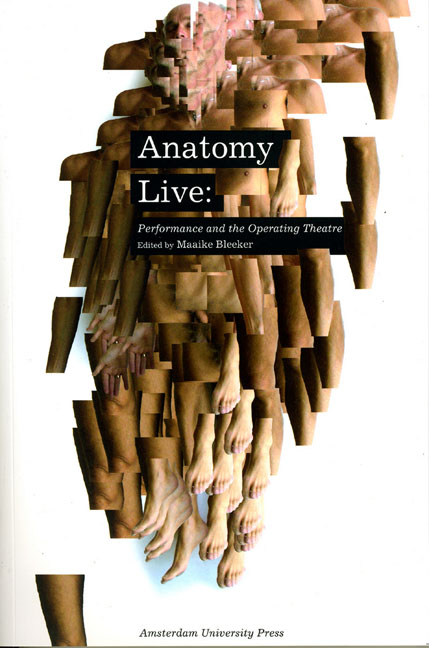Book contents
- Frontmatter
- Contents
- Acknowledgements
- Prologue - Men with Glass Bodies
- Introduction
- Performance Documentation 1: Holoman; Digital Cadaver
- Digital Cadavers and Virtual Dissection
- ‘Who Were You?’: The Visible and the Visceral
- Performance Documentation 2: Excavations: Fresh but Rotten
- The Anatomy Lesson of Professor Moxham
- ‘Be not Faithless But Believing’: Illusion and Doubt in the Anatomy Theatre
- Performance Documentation 3: De Anatomische Les
- Of Dissection and Technologies of Culture in Actor Training Programs – an Example from 1960s West Germany
- Ocular Anatomy, Chiasm, and Theatre Architecture as a Material Phenomenology in Early Modern Europe
- Performance Documentation 4: Camillo – Memo 4.0: The Cabinet of Memories – A Tear Donnor Session
- Martin, Massumi, and the Matrix
- Performance Documentation 5: Sensing Presence no 1: Performing a Hyperlink System
- ‘Where Are You Now?’: Locating the Body in Contemporary Performance
- Performance Documentation 6: Under My Skin
- Anatomies of Live Art
- Performance Documentation 7: Crash
- Restaging the Monstrous
- Delirium of the Flesh: ‘All the Dead Voices’ in the Space of the Now
- Performance Documentation 8: Körper
- Operating Theatres: Body-bits and a Post-apartheid Aesthetics
- Index
Ocular Anatomy, Chiasm, and Theatre Architecture as a Material Phenomenology in Early Modern Europe
Published online by Cambridge University Press: 10 February 2021
- Frontmatter
- Contents
- Acknowledgements
- Prologue - Men with Glass Bodies
- Introduction
- Performance Documentation 1: Holoman; Digital Cadaver
- Digital Cadavers and Virtual Dissection
- ‘Who Were You?’: The Visible and the Visceral
- Performance Documentation 2: Excavations: Fresh but Rotten
- The Anatomy Lesson of Professor Moxham
- ‘Be not Faithless But Believing’: Illusion and Doubt in the Anatomy Theatre
- Performance Documentation 3: De Anatomische Les
- Of Dissection and Technologies of Culture in Actor Training Programs – an Example from 1960s West Germany
- Ocular Anatomy, Chiasm, and Theatre Architecture as a Material Phenomenology in Early Modern Europe
- Performance Documentation 4: Camillo – Memo 4.0: The Cabinet of Memories – A Tear Donnor Session
- Martin, Massumi, and the Matrix
- Performance Documentation 5: Sensing Presence no 1: Performing a Hyperlink System
- ‘Where Are You Now?’: Locating the Body in Contemporary Performance
- Performance Documentation 6: Under My Skin
- Anatomies of Live Art
- Performance Documentation 7: Crash
- Restaging the Monstrous
- Delirium of the Flesh: ‘All the Dead Voices’ in the Space of the Now
- Performance Documentation 8: Körper
- Operating Theatres: Body-bits and a Post-apartheid Aesthetics
- Index
Summary
Husserlian phenomenology, long a critical apparatus employed by theatre and performance scholars, is already infiltrated by a theatrical mode of thought that is more or less explicit in much of Husserl 's philosophy. It has chimerically incorporated the architecture of the theatre in the mode of the Western, frontally oriented, proscenium stage. Supporting such a claim requires a careful calibration of the terms of ‘phenomenology’ and of ‘theatre architecture ‘ as historically bounded modes of thought, each of which reflects an underlying condition of knowing, or connaissance, that is itself conditioned by history. The articulation of this connaissance is manifested in phenomenology 's tendency to build a structural consciousness, member by member, as though it were an architectural entity. Husserlian phenomenology can be seen as constituted by and as possessor of an architectonics that is distinctly theatrical in that it adopts certain spatial attributes of theatre architecture of the Renaissance and modern era.
If it can be demonstrated that theatrical architecture as an ideal, if malleable, structure was available for more or less explicit incorporation into Husserl 's project, then one wonders 1) what attributes would recommend this particular architectural model above others and 2) what genealogical factors shaped theatre architecture such that these attributes were incorporated into it in the first place. It is here that the figure of the chiasm, a crossing of positional terms over each other in space, can be found occupying a central position in every sense.
Western theatre architecture developed contemporaneously with the rationalization of ocular anatomy to geometric optics from the seventeenth century onwards, and there is reason to believe that the morphology of both types of structure manifests a grand, diffuse reorientation of mankind's relationship to the world. As vision, constituted in the emerging understanding of the eye's function, came to be a central figure for man's relationship to other things (which is to say, objectivity), theatre buildings came to model this same relationship and to embody an isomorphism with ocular anatomy. In each case, the relationship of the subject to the object is spatially figured by a chiasm that mediates between one and the other.
- Type
- Chapter
- Information
- Anatomy LivePerformance and the Operating Theatre, pp. 129 - 146Publisher: Amsterdam University PressPrint publication year: 2008



